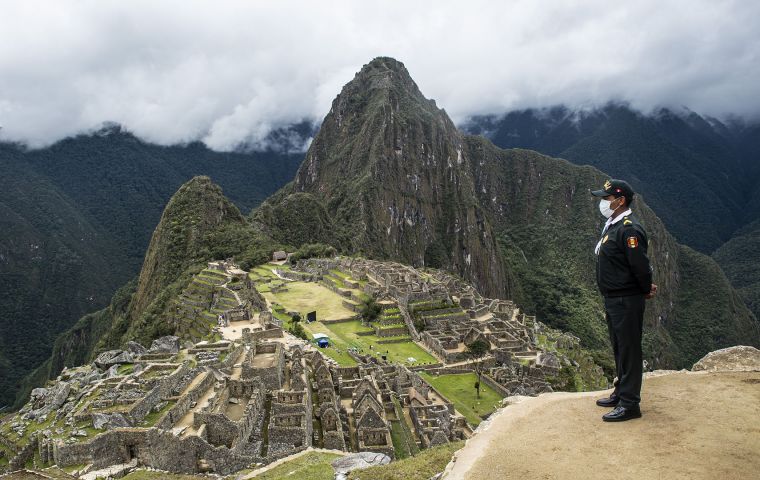MercoPress. South Atlantic News Agency
Machu Picchu, crown jewel of Peru's tourist sites has reopened
 For safety reasons, however, only 675 tourists will be able to access the site per day, just 30 percent of the number of visitors pre-pandemic.
For safety reasons, however, only 675 tourists will be able to access the site per day, just 30 percent of the number of visitors pre-pandemic. The Inca citadel of Machu Picchu, the crown jewel of Peru's tourist sites, reopened on Sunday with an ancient ritual after a nearly eight-month lockdown due to the novel coronavirus pandemic.
For safety reasons, however, only 675 tourists will be able to access the site per day, just 30 percent of the number of visitors pre-pandemic.
Under a fine drizzle and multicolored lights, an Inca ritual was held Sunday evening to thank the gods for the citadel's reopening.
”Today, Machu Picchu opens. It opens with (health and safety) protocols, it opens to say that we are reactivating ourselves but with responsibility and great prudence, because we see everything happening in the world“ with the pandemic, Foreign Trade and Tourism Minister Rocio Barrios said in a speech.
The first train of tourists, along with journalists arrived on Sunday morning at Machu Picchu Pueblo, the village closest to the citadel, after a 90-minute journey along the Urubamba River from the ancient Inca village of Ollantaytambo.
Opening Machu Picchu to the world shows ”that we Peruvians are resilient,“ Barrios said.
The number of coronavirus cases has been steadily decreasing in Peru, and tourists will be expected to maintain social distancing.
The coronavirus lockdown has been a body blow to the tens of thousands of people who make their living from the country's tourism industry, especially those in the mountainous Cusco region where the stone citadel is located.
Scores of hotels, restaurants and tourism-related businesses throughout the region went bankrupt by the time a strict mandatory virus lockdown that lasted more than 100 days was lifted in July.
Before the pandemic there were 80 hotels of various types in Ollantaytambo, a town with an imposing Inca stone fortress located at the end of the road from Cusco to Machu Picchu.
”At least half of them have gone bankrupt,” said Joaquin Randall, head of the local hotel and restaurant association.
Machu Picchu, which means old mountain in Quechua, is the most enduring legacy of the Inca empire that ruled a large swathe of western South America for 100 years before the Spanish conquest in the 16th century.
The ruins of the Inca settlement, abandoned and overgrown by vegetation, were rediscovered in 1911 by the American explorer Hiram Bingham. In 1983, UNESCO declared Machu Picchu a World Heritage Site.




Top Comments
Disclaimer & comment rulesCommenting for this story is now closed.
If you have a Facebook account, become a fan and comment on our Facebook Page!